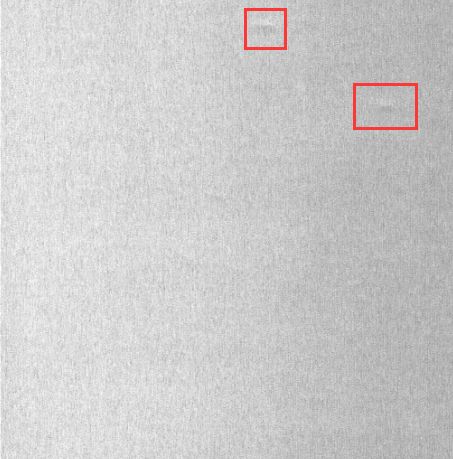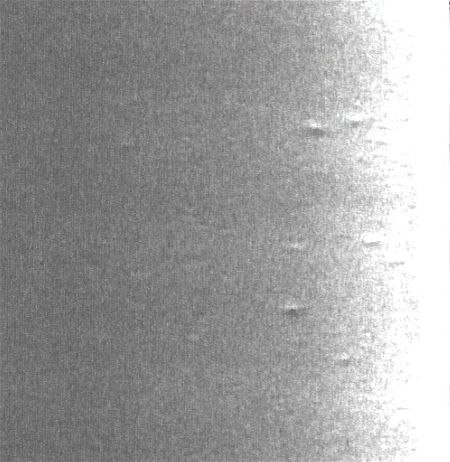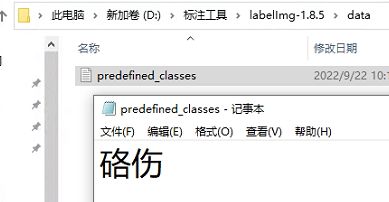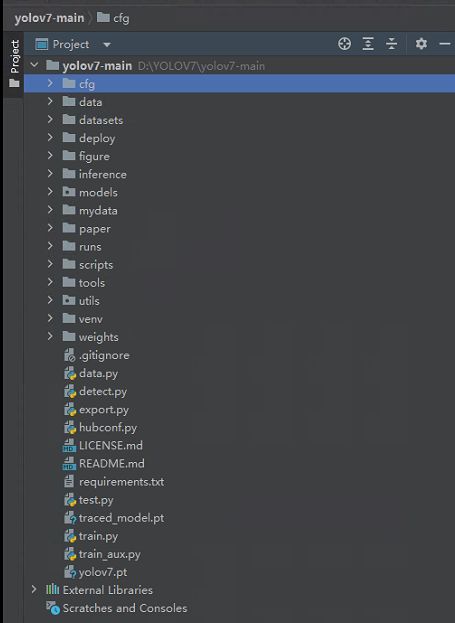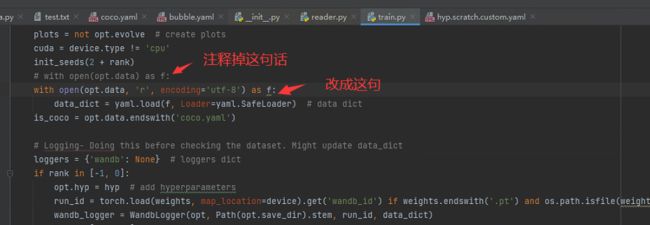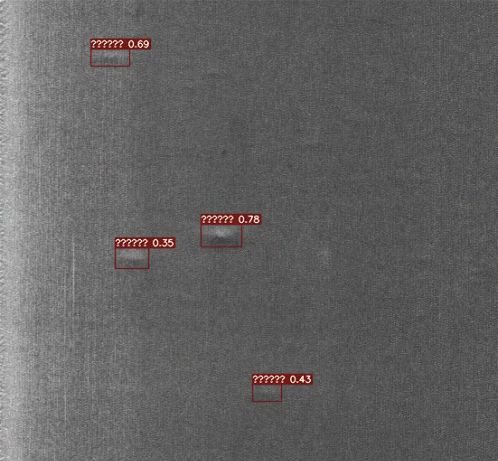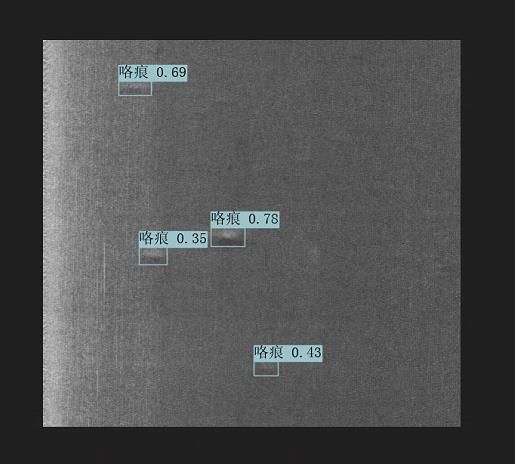Yolov7训练自己的数据集(超详细)
目录
一,准备数据集
1.1 挑选照片
1.2 做标注
二,下载YoloV7
三,划分数据集
四,模型训练
4.1 创建yaml文件
4.2 修改默认参数
4.3 开始训练
五,训练模型遇到的问题
5.1 UnicodeDecodeError: 'gbk' codec can't decode type 0xaf in position 525: illegal multibyte sequence
5.2 subprocess.Called processError: Command 'git tag' returned non-zero exit status 128
六,测试
七,解决标签中文显示问题
一,准备数据集
1.1 挑选照片
公主做的是缺陷检测方向,没有好办法,只能靠人眼,公主试过用阈值分割法来挑选,但是!如果阈值分割法能准确分离缺陷,就不用用yolo了不是?特别是灰度相近,而且每张照片灰度都不同,背景与缺陷灰度对比度很接近,比如上图中的硌伤~特别是背景有噪声的时候如下图,阈值分割法就直接躺平了~
没办法,从4T的数据里挑出来,挑的公主眼睛都要瞎了~~~
1.2 做标注
公主用的labelImg,大部分做yolo标注都用这个,也是很主流的标注工具,安装方法见公主另一篇博客。那篇博客标注方法没写全,在这里详细介绍一下:
(1)修改默认标签。公主先只做了一种缺陷,缺陷名称为“硌伤”,因此只写了一种class。在labelImg的安装文件夹中的data/predefined_classes里面修改class:
(2)创建images文件夹和labels文件夹,可以放在任意的文件夹下。将挑选出的照片放到images的文件夹中。
(3)在cmd中cd到labelImg文件夹下,运行python labelImg命令打开labelImg主页面。或者直接在pycharm的Terminal中打开也行,公主是直接用pycharm的Terminal来运行的。
![]()
(4)在主页面上打开待标注文件,进行标注
labelImg如上图所示。
-
- 第一步先将标注类型改为YOLO,这一步非常关键!
- 第二部修改Save Dir到之前创建的labels的文件夹
- 第三步Open Dir,打开之前创建的images文件夹,此时会出现4框中的所有文件
- 双击想要标注的图像,通过Create RectBox在需要标注的位置画出框,选好标注类型就可以啦~
- 可以选中View->Auto Save Mode,这样标注完就不用手动点Save了,直接点Next Image跳到下一张即可自动保存。
- 此时可以看到labels文件夹中多了一个与图像同名的.txt文件,即为标注文件啦!注意,标注与图片是一一对应的!
labels的格式如下:
二,下载YoloV7
下载地址
下载之后的目录结构是这样的:
三,划分数据集
由于公主是一股脑将所有图像放到一起了,由于工业生产的特殊性,临近时间产生的缺陷相似,因此需要随机将图像拆分为训练集,验证集及测试集。
在yolov7-main主文件夹下创建data.py, 并在datasets文件夹下创建defect文件夹,目录结构如下:红框画出的文件是下面代码运行完后自动生成的。
公主在这篇博客的代码基础上修改了一下,同时生成了yolov7需要的目录文件,代码如下:
# 将图片和标注数据按比例切分为 训练集和测试集
import shutil
import random
import os
# 原始路径
image_original_path = "./mydata/images/"
label_original_path = "./mydata/label/"
cur_path = os.getcwd()
# 训练集路径
train_image_path = os.path.join(cur_path, "datasets/defect/images/train/")
train_label_path = os.path.join(cur_path, "datasets/defect/labels/train/")
# 验证集路径
val_image_path = os.path.join(cur_path, "datasets/defect/images/val/")
val_label_path = os.path.join(cur_path, "datasets/defect/labels/val/")
# 测试集路径
test_image_path = os.path.join(cur_path, "datasets/defect/images/test/")
test_label_path = os.path.join(cur_path, "datasets/defect/labels/test/")
# 训练集目录
list_train = os.path.join(cur_path, "datasets/defect/train.txt")
list_val = os.path.join(cur_path, "datasets/defect/val.txt")
list_test = os.path.join(cur_path, "datasets/defect/test.txt")
train_percent = 0.6
val_percent = 0.2
test_percent = 0.2
def del_file(path):
for i in os.listdir(path):
file_data = path + "\\" + i
os.remove(file_data)
def mkdir():
if not os.path.exists(train_image_path):
os.makedirs(train_image_path)
else:
del_file(train_image_path)
if not os.path.exists(train_label_path):
os.makedirs(train_label_path)
else:
del_file(train_label_path)
if not os.path.exists(val_image_path):
os.makedirs(val_image_path)
else:
del_file(val_image_path)
if not os.path.exists(val_label_path):
os.makedirs(val_label_path)
else:
del_file(val_label_path)
if not os.path.exists(test_image_path):
os.makedirs(test_image_path)
else:
del_file(test_image_path)
if not os.path.exists(test_label_path):
os.makedirs(test_label_path)
else:
del_file(test_label_path)
def clearfile():
if os.path.exists(list_train):
os.remove(list_train)
if os.path.exists(list_val):
os.remove(list_val)
if os.path.exists(list_test):
os.remove(list_test)
def main():
mkdir()
clearfile()
file_train = open(list_train, 'w')
file_val = open(list_val, 'w')
file_test = open(list_test, 'w')
total_txt = os.listdir(label_original_path)
num_txt = len(total_txt)
list_all_txt = range(num_txt)
num_train = int(num_txt * train_percent)
num_val = int(num_txt * val_percent)
num_test = num_txt - num_train - num_val
train = random.sample(list_all_txt, num_train)
# train从list_all_txt取出num_train个元素
# 所以list_all_txt列表只剩下了这些元素
val_test = [i for i in list_all_txt if not i in train]
# 再从val_test取出num_val个元素,val_test剩下的元素就是test
val = random.sample(val_test, num_val)
print("训练集数目:{}, 验证集数目:{}, 测试集数目:{}".format(len(train), len(val), len(val_test) - len(val)))
for i in list_all_txt:
name = total_txt[i][:-4]
srcImage = image_original_path + name + '.bmp'
srcLabel = label_original_path + name + ".txt"
if i in train:
dst_train_Image = train_image_path + name + '.bmp'
dst_train_Label = train_label_path + name + '.txt'
shutil.copyfile(srcImage, dst_train_Image)
shutil.copyfile(srcLabel, dst_train_Label)
file_train.write(dst_train_Image + '\n')
elif i in val:
dst_val_Image = val_image_path + name + '.bmp'
dst_val_Label = val_label_path + name + '.txt'
shutil.copyfile(srcImage, dst_val_Image)
shutil.copyfile(srcLabel, dst_val_Label)
file_val.write(dst_val_Image + '\n')
else:
dst_test_Image = test_image_path + name + '.bmp'
dst_test_Label = test_label_path + name + '.txt'
shutil.copyfile(srcImage, dst_test_Image)
shutil.copyfile(srcLabel, dst_test_Label)
file_test.write(dst_test_Image + '\n')
file_train.close()
file_val.close()
file_test.close()
if __name__ == "__main__":
main()至此,数据集彻底准备完毕!
CUDA的安装我是参考这篇博客。
四,模型训练
4.1 创建yaml文件
在data文件夹中创建新的yaml文件,本例中缺陷为硌痕(公主不知道硌痕怎么翻译,长得像气泡,就翻译成了bubble >_<)。把coco.yaml文件复制过来,根据自己的要求修改。
4.2 修改默认参数
根据自己的情况修改,参数代表的意思可以参考这篇博客,讲的非常详细。
公主只改了这三个,
-
- --data:是必改的。
- --epochs:公主的缺陷类型比较简单,好识别,因此只设了200个epochs,实际上150个左右的时候就差不多收敛了。
- --batch-size:公主的显卡显存不太行,只设了8个。但照片数量少,只有一千张左右,因此速度也不算慢。
- --img-size:本例训练集照片是512*512的,因此公主使用了默认的[640 640]
4.3 开始训练
由于默认参数已经修改了,训练时直接运行命令
![]()
即可。
训练时:
训练完毕会提示:
最后一轮迭代的权重文件放在runs\train\exp6\weights\last.pt中,最好的权重文件放在runs\train\exp6\weights\bext.pt中。
五,训练模型遇到的问题
5.1 UnicodeDecodeError: 'gbk' codec can't decode type 0xaf in position 525: illegal multibyte sequence
查了下原因是python和win10系统,打开文件时默认的编码方式冲突导致:python默认的是gbk,而win10默认的是utf-8,所以只要改一下python打开文件时,默认的编码就行。(PS:开始公主用的官网默认的 --batch-size 32,然后GPU out of memory了,改成16,还是out of memory,最后含泪改成8.截上图的时候还没到out of memory那一步,因此--batch-size还是32)
5.2 subprocess.Called processError: Command 'git tag' returned non-zero exit status 128
主要原因是因为request请求访问github被墙,解决方案就是手动下载所需的yolov7.pt权重文件,地址为https://github.com/WongKinYiu/yolov7。下载之后放在主目录下,然后还要把train.py中的权重从yolo7.pt改为yolov7.pt,
六,测试
在datasets\defect中新建一个文件夹testImages。运行detect.py
在runs\defect\exp2中打开文件查看
哎呦,标的很准,可是,由于标签是中文,显示乱码“?????”怎么办呢?
七,解决标签中文显示问题
为啥显示乱码呢?查了下资料,原来是opencv的cv2.putText()不支持中文。只能重写plots.py里的plot_one_box()函数,根据这篇博客的介绍。将plot_one_box重写如下:
def plot_one_box(x, img, color=None, label=None, line_thickness=3):
# Plots one bounding box on image img
tl = line_thickness or round(0.002 * (img.shape[0] + img.shape[1]) / 2) + 1 # line/font thickness
color = color or [random.randint(0, 255) for _ in range(3)]
c1, c2 = (int(x[0]), int(x[1])), (int(x[2]), int(x[3]))
cv2.rectangle(img, c1, c2, color, thickness=tl, lineType=cv2.LINE_AA)
if label:
tf = max(tl - 1, 1) # font thickness
t_size = cv2.getTextSize(label, 0, fontScale=tl / 3, thickness=tf)[0]
font_size = t_size[1]
font = ImageFont.truetype(r"D:\YOLOV7\yolov7-main\Font\simsun.ttc", font_size, encoding="utf-8")
t_size = font.getsize(label)
c2 = c1[0] + t_size[0], c1[1] - t_size[1]
cv2.rectangle(img, c1, c2, color, -1, cv2.LINE_AA) # filled
img = Image.fromarray(cv2.cvtColor(img, cv2.COLOR_BGR2RGB))
draw = ImageDraw.Draw(img)
draw.text((c1[0], c2[1]), label, (0, 0, 0), font=font)
# cv2.putText(img, label, (c1[0], c1[1] - 2), 0, tl / 3, [225, 255, 255], thickness=tf, lineType=cv2.LINE_AA)
return cv2.cvtColor(np.array(img), cv2.COLOR_RGB2BGR)为了保证多个标签时能都保存下来
detect.py文件,plot_one_box(xyxy, im0, ....) 修改为 im0 = plot_one_box(xyxy, im0, ...)
plots.py文件,plot_one_box(box, mosaic,...) 修改为 mosaic = plot_one_box(box, mosaic,...)
最后得到结果:
完美!!!!!
小插曲:在修改中文标签的时候,想用matplotlib.pyplot.imshow()来打印图片,无奈老是不显示。查了很久才发现是matplotlib.get_backend是agg,而agg不支持GUI画图。但在terminal里运行print(matplotlib.get_backend())明明是QtAgg.后来又在程序里打印,仍然是agg。抓狂了很久后才发现,在plots.py中作者写了这句:
太坑了!!!手动改成matplotlib.use('Qt5Agg'),原码是matplotlib.use('Agg')。
PS:本文与Yolov7训练自己的数据集(超详细) - 玻璃公主 - 博客园一摸一样,都是公主的博客>_<
